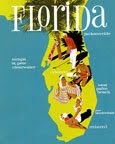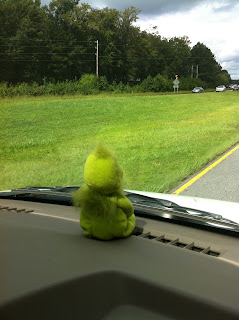“From red clay hills covered with oaks and magnolias, this route descends into a region of flatwoods and runs straight as an arrow for many miles, passing numerous turpentine and sawmill settlements, and then ascends to limestone hills, with lakes between. Green citrus groves, cypress hammocks, and scattered clumps of cabbage palms relieve the somber vista of cut-over pine land and scrub palmetto. Little of this sparsely settled territory is under fence, and free range cattle are a constant menace to motorists. Upon reaching the west coast the highway is within sight of the Gulf of Mexico, with its palm-fringed bayous and ribbon of low-lying keys, on which are miles of glittering white sand beaches.” – Guide to the Southernmost State
 |
| Inscribed over the Monticello courthouse doors: "Suum Cuique", Latin for "To each his own." You could also pronounce it "Sue 'em quick", as the locals do. |
US 19, in the more populous areas of the state, is a nightmare for commuters. In its northern parts, it is a delight, a series of rolling hills and red clay and leafy green trees.
Monticello, at the intersection of US 90 (See Tour 7), emits a distinctly southern vibe, with antebellum homes, an 1890s opera house, and a crumbly cemetery. The pre-civil war construction, so rarely seen in Florida, exists solely by virtue of poverty – when residents couldn’t afford to build new homes during the Great Depression, they instead renovated the older homes. Today they can be seen on a leisurely drive through the town, or by taking a Chamber of Commerce historical walking tour beneath the stately live oaks lining the streets. Homes have roomy porches, maid’s quarters, and gingerbread trim.
 This, I note, does not feel a bit like the Florida I know. The Florida I know overflows with sandy ranch houses, Florida rooms lined with cool tarazzo floors, and salt-crusted boats bobbing in emerald bays. But Monticello presents itself not as aquamarine waters and streaky pink sunsets but with muted colors of the forest–green pine trees and carmine-kissed clay soil.
This, I note, does not feel a bit like the Florida I know. The Florida I know overflows with sandy ranch houses, Florida rooms lined with cool tarazzo floors, and salt-crusted boats bobbing in emerald bays. But Monticello presents itself not as aquamarine waters and streaky pink sunsets but with muted colors of the forest–green pine trees and carmine-kissed clay soil.
I linger in Roseland cemetery, trying to make out the inscriptions on the moldering tombs. The cemetery dates to 1827 and I find out later that I could have taken a ghost tour through the cemetery. I do not regret not taking the tour; the old stones, aging brick, and moss-draped trees gave the burial ground a desolate, haunted feel without help from paid storytellers.
Every summer, Monticello crowns a Watermelon Queen. In the late 1800s, Monticello and surrounding Jefferson County provided the country with the bulk of its watermelon seeds. The annual festival honoring this juicy slice of the town’s history includes bed races, plenty of food, and watermelon carving. I will leave the pageantry of the crowing of the Queen to your imagination.
Further down the road at Capps, the road joins with US 27 and US 19 and runs south through Perry and the Steinhatchee Conservation Area. If you love jellies and jams, this stretch of road has Florida’s finest on offer. I re-stock my supply of mayhaw jelly, Tupelo honey, and whatever vegetables the unfailingly cheerful roadside salesmen have on offer. Mayhaw berries, which grow in wet, low lying areas with sediment-rich, acidic soil, look like cranberries but don’t taste like them. They taste like… well, they taste like mayhaws, sweet and tart and gentle and sharp, which tells you nothing, I realize.
Further down the road at Capps, the road joins with US 27 and US 19 and runs south through Perry and the Steinhatchee Conservation Area. If you love jellies and jams, this stretch of road has Florida’s finest on offer. I re-stock my supply of mayhaw jelly, Tupelo honey, and whatever vegetables the unfailingly cheerful roadside salesmen have on offer. Mayhaw berries, which grow in wet, low lying areas with sediment-rich, acidic soil, look like cranberries but don’t taste like them. They taste like… well, they taste like mayhaws, sweet and tart and gentle and sharp, which tells you nothing, I realize.
The trees grow in swampy north Florida, in the panhandle and along the east side of the state as far south as Marion and Volusia (think Ocala and Dayotona Beach) counties, but I find the tastiest jelly along this stretch of US 19.
And what a lovely stretch of road it is, yawning greatly before us as we trundle towards the Tampa Bay area: trees in a thousand shades of green, the odd store or gas station, and not much else. I wouldn’t want to break down here, but I love the drive along the wooded highway. If one gauged the wealth of the residents by the number of shopping malls, they would deduce this is poor man’s country. If instead one looked at the number of birds, pines, and foliage, one might think the people here quite wealthy.








